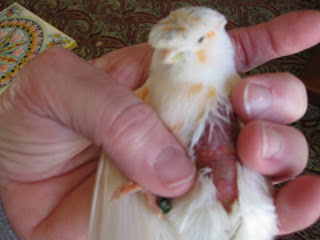And the winner is.....Ralph R. Tepedino!
...The key word here is "immediately" - pair her with an appropriate mating "ready" cock; Linda's hen has caught the breeder's eye by showing nesting behavior in a bowl of blue mineral grit. When checking the hen's vent, the breeder will find the beginning signs of swelling and fullness; Linda's hen is beginning to show the natural progression of egg development but will not likely lay her first egg for another fourteen to eighteen days. There is no "immediate" urgency to pair her with a mating-ready cock for she has a number of weeks before laying! Setting-up Linda's hen with a ready cock may result in squabbling...Linda's hen is not ready to accept the lustily singing cock whose chase to breed may result in stressing-out the hen or cock, feather plucking, and unnecessary injury or death. Always avoid STRESS in the breeding cage! If you pair these birds and notice the gentle sounds of cooing and mutual acceptance, you can keep this pair together but keep a watchful eye for possible disturbance; the cock in this situation will generally speed-up the hen's nest building and egg production. A is not my answer.
Setting-up Linda's hen with a cock who is behind in vent development and not in breeding condition, with the key word being "immediately" will not accomplish anything! Pairing up this scenario will prove to be time consuming and more unnecessary work for the breeder in the maintenance of the breeding cage regarding keeping the breeding cage clean, the result of soiled nestling material, the likely possibility of non-acceptance by the hen or cock; resulting with "clear eggs". Again, Linda's typy variegated mosaic Stafford Hen has weeks to go before settling-in and laying her first egg...no immediate action necessary; thus B is not my answer.
To arrest the blue hen's development by suddenly dropping the lighting intensity and dropping her total hours of daylight exposure to 9 or 10 hours per day will serve no purpose in the breeding room. First of all, it will affect all birds in the breeding program but not necessarily in a negative way. Linda's birds, by evidence of the "blue hen", are coming into breeding condition; the reduction of light will have little affect on hens or cocks in late February. Spring is just around the corner, and is the season for soft bill domestic birds and wild birds to breed. You should not arrest a canary to breed-in-season, you should progressively condition and prepare the breeding cage for the blue-hen ready candidate. C is not at all my answer!
"Wait & Watch Her" and less human interference with "Mother Nature" is MY ANSWER! If Linda Hogan's hen were caged with other hens or cocks, I would simply set her up in her permanent staged breeding cage with nest, nesting material; without the cock. Usually within days, if not the next morning, her nest building activities will be in full gear; when the hen preps the bottom/center of the nest, now it's time to introduce the cock, always in the a.m. hour of the day. The ideal situation would be immediate copulation and acceptance...SUCCESS! The key words with Canaries is to "Watch" and "Wait" and you'll know always your next move. D IS MY ANSWER!
I'm enjoying your canarytales blog Linda, and look forward to reading your educational canary tales authored by an exceptional bird hobbyiest.
Yours In The Fancy
Ralph R. Tepedino
Cottage Blue Aviary










































